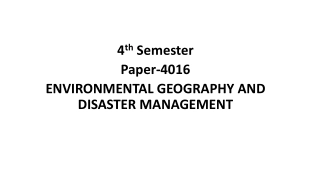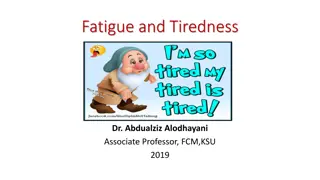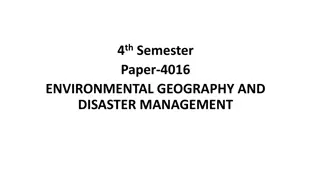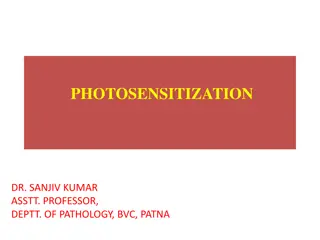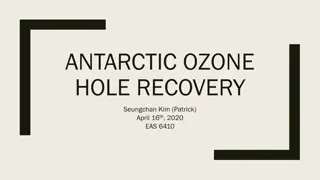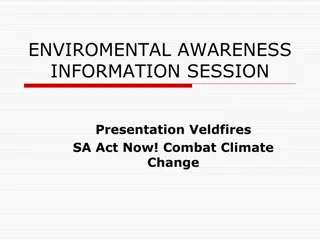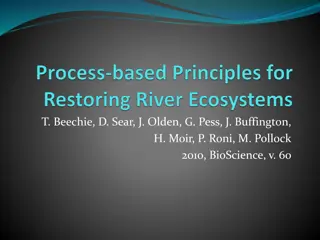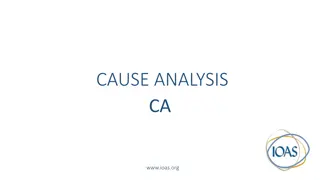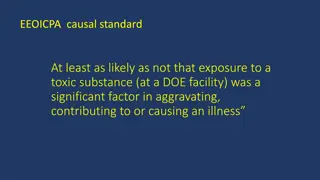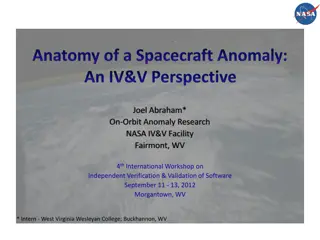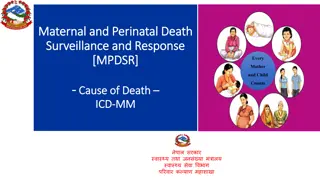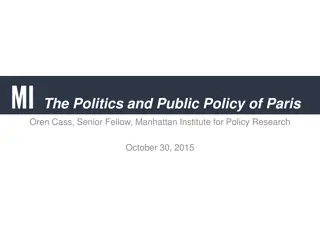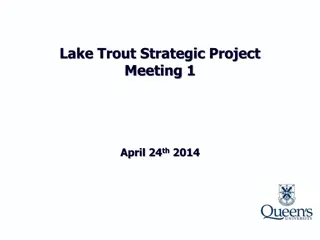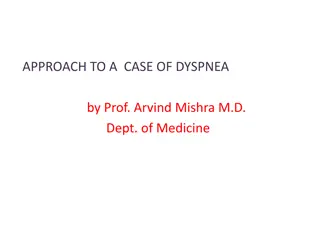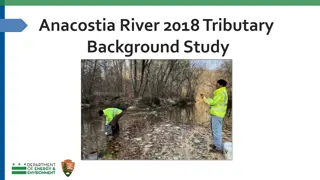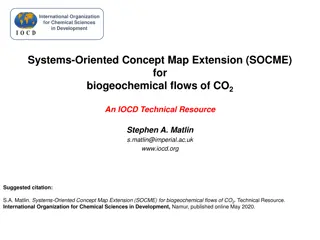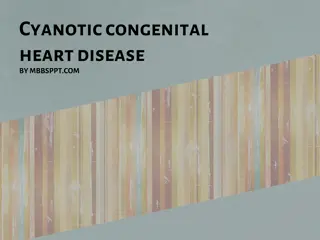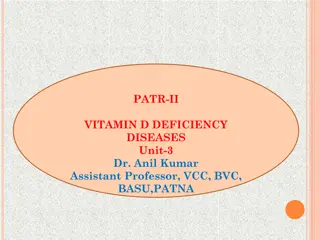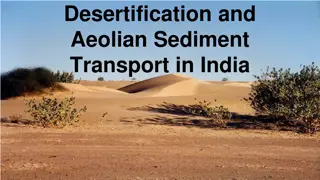Environmental Geography and Disaster Management
The causes, impacts, and management strategies for forest fires/wildfires. Learn about anthropogenic causes, natural causes like lightning, and the threat they pose to biodiversity and ecosystems.
2 views • 13 slides
Understanding Fatigue: Definitions, Causes, and Management
Fatigue is defined as an unpleasant symptom that affects an individual's normal functioning capacity. It can manifest as tiredness, weakness, or lack of energy. Common causes of fatigue include sleep loss, heavy physical or mental work, and chronic conditions like Chronic Fatigue Syndrome. The manag
3 views • 36 slides
Understanding Forest Fires and Their Causes in India
Forest fires have become increasingly common in India, with recent incidents in various states causing significant damage to biodiversity and ecology. Factors such as smoking, campfires, fireworks, burning debris, and natural causes like lightning contribute to the occurrence of these devastating fi
0 views • 13 slides
Understanding Cybercrime: Causes, Definitions, and Consequences
Explore the world of cybercrime through discussions on its causes, definitions, and consequences. Discover the motives behind cybercriminal activities, learn about the various online crimes committed, and decipher the impacts of such actions. Delve into themed activities like cracking codes, idea sh
2 views • 16 slides
Causes of Disabilities Across Different Stages of Life
Disabilities can arise at various stages of life, including prenatal, perinatal, infancy, early childhood, adolescence, adulthood, and old age. The causes of disabilities can be categorized into prenatal, perinatal, and postnatal factors. Prenatal causes include genetic deformities, maternal health
0 views • 24 slides
Understanding Stillbirth: Causes, Symptoms, and Investigations
Stillbirth, the delivery of a baby with no signs of life after 20 completed weeks of pregnancy, can have profound emotional and social effects. Unexplained causes account for 50% of cases, with fetal, placental, and maternal factors contributing. Risk factors include obesity, maternal age, smoking,
2 views • 26 slides
Understanding Photosensitization in Animals - Causes and Types
Photosensitization in animals is the activation of photodynamic chemicals on the skin by UV or visible light, leading to cellular damage and inflammation. Factors necessary for photosensitization include oxygen, sunlight, specific chemicals, and skin lacking pigments. Types of photosensitization inc
1 views • 8 slides
Understanding Diabetes: Type 1 vs. Type 2, Causes, Treatments, and Modern Methods
Explore the differences between type 1 and type 2 diabetes, including causes, effects, treatments, and associated problems. Compare the causes and treatments of both types of diabetes while evaluating modern methods of treatment. Understand the symptoms, lifestyle factors, and risk factors related t
0 views • 18 slides
Understanding Environmental Hygiene: Air Pollution and Composition of Air
The content delves into the concept of atmospheric pollution, the composition of pure and impure air, sources of air pollution, and the zones of the atmosphere. It highlights the detrimental effects of pollutants on health and the environment, emphasizing the importance of environmental hygiene. The
1 views • 27 slides
UNICEF Conceptual Framework on the Causes of Malnutrition
The UNICEF conceptual framework on the causes of malnutrition outlines the multidimensional factors contributing to malnutrition, categorized into immediate, underlying, and basic causes. Immediate causes include inadequate dietary intake and diseases, while underlying causes involve issues like ina
2 views • 18 slides
Antarctic Ozone Hole Recovery and Future Challenges
Depletion of the stratospheric ozone layer in Antarctica due to chlorine emissions led to the formation of the ozone hole. Since the phasing out of Ozone-Depleting Substances (ODSs) under the Montreal Protocol, there has been a reduction in anthropogenic ODSs in the troposphere. Observations and che
0 views • 12 slides
Understanding Nephritis: Causes, Symptoms, and Subtypes
Nephritis is a serious medical condition characterized by inflammation of the nephrons in the kidneys. This inflammation can lead to various subtypes such as glomerulonephritis and interstitial nephritis, each with its own causes and symptoms. Common symptoms of nephritis include edema, changes in u
0 views • 26 slides
Veldfires in South Africa: Causes, Impacts, and Solutions
In this environmental awareness information session presentation, the focus is on veldfires in South Africa. The presentation covers event objectives, causes of veldfires, their impact, and solutions to combat climate change. It emphasizes the importance of identifying causes, understanding impacts,
1 views • 15 slides
First Retrievals of Methane Isotopologue CH3D in High Arctic - EUREKA Workshop
Atmospheric methane, a key anthropogenic greenhouse gas, has seen a significant increase since pre-industrial times. The study focuses on retrieving the isotopologue CH3D from ground-based FTIR observations in the high Arctic, using specialized instrumentation and datasets. The research aims to unra
0 views • 16 slides
Exploring the Existence of Causes in Nature and Human Understanding
The discussion delves into whether everything has a cause and if humans can comprehend all causes. It contrasts functional and formal approaches, questioning the universal expectation that phenomena have causes and if humans can identify them all. Various linguistic theories are referenced, emphasiz
0 views • 27 slides
Principles and Advantages of Process-Based River Restoration
This paper discusses the decline of river health due to human activities, emphasizing the need for sustainable restoration practices. It explores process-based restoration, highlighting its benefits and principles such as targeting root causes, matching restoration scale to environmental processes,
2 views • 20 slides
Revisiting Davidson's Arguments on Actions, Reasons, and Causes
Over sixty years after the publication of Donald Davidson's seminal paper on Actions, Reasons, and Causes, there is ongoing debate about whether rationalization is a form of causal explanation. This article challenges Davidson's viewpoint and discusses the relation between reasons and actions, explo
0 views • 107 slides
Seasonality of Particles Exported by the Southern Ocean Eddy Subduction Pump
The Southern Ocean Eddy Subduction Pump plays a crucial role in global carbon cycling, contributing significantly to the ocean's uptake of anthropogenic CO2. This research aims to characterize the seasonality and particle assemblage of the pump to better understand its role in carbon export. Various
0 views • 35 slides
Advancements in Chemical Mechanisms for Aerosol Effects in WRF/Chem Model
This study focuses on the development of a new chemical mechanism in the Weather Research and Forecasting with Chemistry (WRF/Chem) model to address the underestimation of carbonaceous aerosols. The RACM/MADE/SOA-VBS mechanism incorporates advancements in gas-phase chemistry and particle parameteriz
0 views • 12 slides
Understanding Spinal Canal Stenosis: Causes, Symptoms, and Classification
Spinal canal stenosis is the abnormal narrowing of the spinal canal or intervertebral foramina, leading to compression of nerves and blood vessels. It can result in symptoms such as radiculopathy, claudication, myelopathy, and more. Cervical stenosis presents with arm pain and weakness, while lumbar
0 views • 18 slides
Understanding Cause Analysis in Problem Solving
Cause analysis, or CA, is a vital tool for investigating incidents, identifying underlying causes, and implementing corrective actions to prevent recurrence. By delving deep into the root causes of problems, CA enables organizations to make effective recommendations and address issues at their sourc
0 views • 12 slides
Understanding Causal Factors in Illness: Toxins, Smoking, and Contributing Causes
Causal standards for illness attribution, toxins' role in disease onset and expression, and the impact of factors like smoking and contributing causes on health outcomes are explored. The distinction between certain and contributing causes, as well as the level of certainty in carcinogen classificat
1 views • 19 slides
On-Orbit Anomaly Research at NASA: Causes and Solutions
On-Orbit Anomaly Research (OOAR) at NASA's IV&V Facility involves studying mishaps related to space missions, identifying anomalies, and improving IV&V processes. The research delves into the causes of anomalies, such as operating system faults, and proximate causes like software deficiencies. Detai
0 views • 20 slides
Understanding Maternal and Perinatal Death Surveillance and Response
Explore the causes and classification of maternal and perinatal deaths, emphasizing the importance of determining the primary, contributory, and final causes of death. Learn how to categorize maternal deaths according to ICD-MM and perinatal deaths according to ICD-PM classifications. Delve into the
0 views • 61 slides
Understanding Aristotle's Theory of the 4 Causes in Physics
Dig into Aristotle's theory of the 4 causes applied to inanimate objects, exploring the nature of something, the intellectual context regarding change, and the significance of causes in philosophical inquiry.
0 views • 18 slides
Understanding Peptic Ulcers: Causes, Symptoms, and Treatment
Peptic ulcers are open sores that form in the stomach or upper small intestine, leading to symptoms like stomach pain, bloating, and nausea. Common causes include H. pylori infection and NSAID use. Recognizing symptoms, such as burning stomach pain, is crucial for timely diagnosis and management. Se
0 views • 19 slides
Challenges and Debates in Climate Change Policy
The content discusses key arguments and issues surrounding anthropogenic climate change, global policies, developing world emissions, and the failure of current climate change submissions. It emphasizes the need for meaningful collective action and highlights the disconnect between narratives and re
0 views • 13 slides
Lake Trout Strategic Project Meeting Summary
Lake Trout Strategic Project Meeting held on April 24th, 2014, focused on developing new predictive tools to forecast the impact of climate change on hypolimnetic dissolved oxygen concentrations in Lake Trout lakes of Ontario. The meeting agenda covered project objectives, timeline, communication st
0 views • 18 slides
Understanding Chronic Sinusitis in Malaysia: Causes, Symptoms, and Treatment
Chronic sinusitis is a prevalent issue in Malaysia, affecting a significant portion of the population. This condition involves long-term inflammation of the sinuses, often recurring even after treatment. Common causes include allergies, inflammations, bone deformations, and sinus obstructions. Sympt
1 views • 11 slides
Understanding Dyspnea: Causes and Approach by Prof. Arvind Mishra, M.D.
Dyspnea, defined as breathing discomfort, can stem from respiratory or cardiovascular issues. Respiratory causes include airway diseases like asthma, pleural and lung diseases, and chest wall disorders. Meanwhile, cardiovascular causes involve left heart diseases, pulmonary vasculature issues, and p
2 views • 34 slides
Anacostia River Tributary Sediment Study 2018
This study focuses on analyzing bottom sediment samples from five major tributaries of the Anacostia River to determine concentrations of contaminants of concern (COCs) and identify possible point sources of pollution. The research aims to establish anthropogenic background concentrations, compare t
0 views • 10 slides
Systems-Oriented Concept Map Extension for Biogeochemical Flows of CO2
The Systems-Oriented Concept Map Extension (SOCME) explores the biogeochemical flows of CO2, detailing interactions within the ocean and land subsystems, including factors such as uptake by different biomes, anthropogenic CO2 generation, deforestation effects, and energy production contributions. It
0 views • 6 slides
Major Events and Causes of World War II
This content covers the major events and causes of World War II, detailing the timeline from the invasion of Poland to key declarations of war and military strategies employed. The causes are explored, including factors like the Treaty of Versailles, economic instability, fascist expansions, and the
0 views • 17 slides
Understanding Urban Heat Island (UHI) Effect - Causes, Impacts, and Solutions
The Urban Heat Island (UHI) effect, illustrated through images and descriptions, explores the formation of heat bubbles over cities, its causes like dark materials and vegetation loss, effects on clouds and rain, and comparison with heat waves. The issue, both anthropogenic and natural, is highlight
0 views • 26 slides
Causes and features of cyanotic congenital heart disease
This informative content covers the causes and features of cyanotic congenital heart disease, including central cyanosis due to congenital heart diseases like Tetralogy of Fallot, pulmonary atresia, Ebstein anomaly, and more. It also discusses non-cardiac causes of cyanosis related to lung diseases,
0 views • 41 slides
Understanding Rickets: Causes, Symptoms, and Treatment
Rickets is a metabolic bone disorder primarily caused by vitamin D, calcium, or phosphorus deficiency. It leads to softening and weakening of bones, affecting young growing animals. Genetic defects, dietary deficiencies, and malabsorption are common causes. The pathophysiology involves decreased cal
0 views • 22 slides
NSF Atmospheric Chemistry Program Overview
The NSF Atmospheric Chemistry Program aims to characterize the chemical composition of the atmosphere, understand chemical processes, quantify fluxes of chemical substances, study natural and anthropogenic causes of variability, and assess impacts on climate. The program supports research through pe
0 views • 6 slides
California Utility Employees Presentation on Methane Emission Reduction Strategies
The Coalition of California Utility Employees presented strategies for the reduction of methane emissions, focusing on technologically feasible and cost-effective measures to prevent leaks and repair leaking components promptly. The rules and procedures adopted aim to address safety requirements and
0 views • 4 slides
Sustainable Development of Iron and Steel Industry for Climate Change Mitigation
The lecture by Prof. Volodymyr SHATOKHA discusses sustainable development in the iron and steel industry to meet climate change mitigation goals. It examines current global climate targets, the role of the industry in greenhouse gas emissions, and the feasibility of reducing emissions. The study foc
0 views • 27 slides
Understanding Desertification and Aeolian Sediment Transport in India
Climates in India, particularly in the desert areas like Rajasthan, are heavily influenced by the monsoon season, with 32% of the land facing the threat of desertification. The upward eddie wind currents in the region can lift silt and very fine sand up to 4km. Various factors contribute to desertif
0 views • 17 slides
